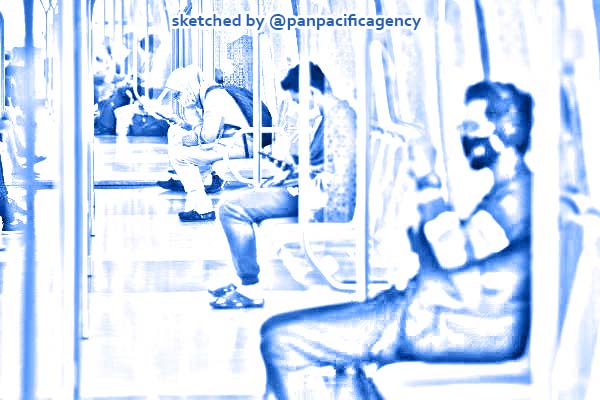Malaysia implements mandatory mask-wearing in crowded places from Aug 1

Commuters are seen wearing face masks in an almost empty SBK train as a precaution against the spread of COVID-19 in Kuala Lumpur, Malaysia (Photo: Reuters/Hazim Mohammad). Sketched by the Pan Pacific Agency.
PETALING JAYA, Aug 1, 2020, The Star. From Saturday (Aug 1), Malaysians will be joining their counterparts in places such as Singapore, Hong Kong, Vietnam, and Victoria in Australia where face masks are mandatory in public spaces to stem the tide of Covid-19 infections, The Straits Times reported.
Under the Prevention and Control of Infectious Diseases Act, those who do not comply with the new rule will face a fine of up to RM1,000 (S$324).
During the height of the Covid-19 outbreak in Malaysia in March, face masks were only required for frontliners such as healthcare workers and those with symptoms of the virus.
But as cases started to re-emerge following the easing of the movement control order (MCO) to the recovery phase, Senior Minister (Security) Datuk Seri Ismail Sabri Yaakob on July 23 announced that face masks would be made compulsory after there was an increase in Covid-19 cases.
Health director-general Datuk Dr Noor Hisham Abdullah had said that the use of face masks would be mandatory at crowded public places.
He added that the long-term plan was to eventually get everyone to wear a face mask once they stepped out of the house.
Medical Practitioners Coalition Association of Malaysia president Dr Raj Kumar Maharajah said wearing face masks helps keep the infectivity rate or the R-naught (R0) rate under 1.0, which means that the probability of an infected person spreading it to others can be minimised.
During the MCO, the R0 rate was at 0.3. It is now at 1.36.
“Wearing face masks could prevent a second wave of the virus,” he said.
“This sacrifice is needed from everyone – at least until a vaccine is ready.”
Apart from wearing face masks, Dr Raj said physical distancing, good hygiene and isolation – for example, by working from home – can also help prevent the spread of the virus.
The World Health Organisation (WHO) has advised people to wear a face mask in public where there is a community transmission and when social distancing is not possible.
WHO said that healthy people wearing face masks can reduce the potential risk of exposure from infected persons who had yet to develop symptoms.
According to the Health Ministry, there were 25 active clusters as at Wednesday with 10 clusters in Sarawak, four in Kuala Lumpur, five in Selangor, two in Johor and the remaining ones in other states.
Dr Noor Hisham attributed the resurgence of cases to the “public’s complacency and their non-compliance with the standard operating procedure (SOP) set by the government”.
There have been incidents where returning travellers breached their mandatory home quarantine.
Identified by their tracking bracelets, they were seen dining at restaurants when they were supposed to be at home.
This sort of defiance had riled up other Malaysians, who took to social media to express their anger at this lack of social responsibility.
Dr Noor Hisham pointed out that if non-compliance and public complacency continued, there was a possibility of another wave of transmissions if the R0 exceeded 1.6.
Malaysians have also been more receptive to the idea of wearing face masks compared with those in nations such as the United States, where some of its citizens have been reluctant to do so.
A poll conducted on The Star’s Facebook page on July 21 found that 41,200 out of 45,700 people who voted had overwhelmingly agreed to make wearing face masks compulsory in public areas.
Meanwhile, ABC News reported that Dr Anthony Fauci, the US National Institute of Allergy and Infectious Diseases director, had suggested Americans also consider wearing goggles or a face shield on top of wearing face masks to protect all mucosal surfaces.
Dr Fauci, however, noted that eye or face shields were “not universally recommended” yet.
When asked about this, Dr Raj said he believed that the use of goggles and face shields would only be necessary in red zones in Malaysia, adding that such equipment should be used together with a face mask.
Red zones are districts with more than 40 local transmissions over a 14-day period, while those with between one and 40 cases are yellow zones, and green zones are those that have no cases.
There are currently 207 active cases in Malaysia.